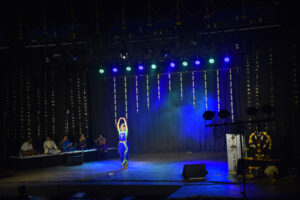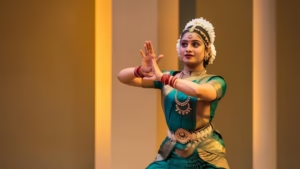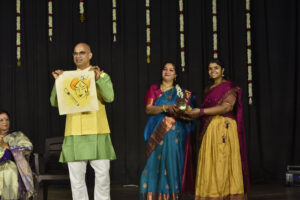If you’ve ever heard the term Arangetram and wondered what it really means, you’re not alone. For many students, parents, and dance lovers, it’s a term that carries weight, pride, and sometimes even pressure.
In this beginner-friendly guide, we break down everything you need to know about the Arangetram ceremony—from its meaning and significance to timelines, preparation, and whether you actually need to do one.
Let’s start with the most asked question.
1. What is an Arangetram?
The word Arangetram comes from Tamil:
- Arangu = Stage
- Etram = Ascent
Put together, Arangetram literally means “ascending the stage.”
It refers to the debut solo performance of a student trained in Bharatanatyam—a classical Indian dance form.
But it’s more than just a stage show.
An Arangetram is a public declaration that the student is now ready to perform independently. It signifies that the Guru (teacher) believes the student has mastered the foundational pieces of Bharatanatyam and can uphold the art form with discipline and respect.
In many ways, an Arangetram is like a graduation ceremony. It comes after years of formal training, and it’s a way to honour the student’s commitment to the dance, the teacher’s guidance, and the tradition itself.
2. When Can I Do My Arangetram?
There is no fixed age or date—it all depends on your readiness.
Most students spend anywhere from 6 to 10 years learning Bharatanatyam before they’re considered ready for an Arangetram. But readiness isn’t just about technical skills. Your teacher will assess:
- Stamina and memory
- Understanding of rhythm (Thalam) and melody (Ragam)
- Command over expressions (Abhinaya)
- Stage presence
- Discipline and commitment
An Arangetram is not done casually. You can’t sign up for it like a dance competition. It is a spiritual and artistic milestone that needs months of focused preparation and complete dedication.
Your Guru will ultimately decide when you are ready. In most schools, you must also show that you can teach or assist junior students and demonstrate consistency in practice.
3. What is the Preparation Process?
Planning and preparing for an Arangetram is a journey in itself.
Here’s what the preparation usually involves:
a. Learning the Full Repertoire
A traditional Bharatanatyam Arangetram typically includes the following sequence:
- Pushpanjali – An invocation piece
- Alarippu – A pure dance item (a precursor)
- Jatiswaram / Thodayamangalam – A pure dance item (the real thing)
- Shabdam – A piece combining rhythm and expression
- Varnam – The centrepiece showcasing the dancer’s stamina, expressions, and storytelling skills
- Padams / Javalis – Expressive pieces exploring emotions (Abhinaya)
- Thillana – A vibrant rhythmic finale
- Mangalam – A concluding blessing
Each piece involves understanding Ragam and Thalam (melody and rhythm) deeply. The dancer must rehearse these with live musicians or recorded audio, ensuring timing and expressions align perfectly.
b. Costume and Makeup Trials
You’ll need Bharatanatyam costumes—usually custom-made—along with jewellery, makeup, and hair accessories. These need to be trial-tested ahead of time to ensure no discomfort or wardrobe issues during the performance.
c. Technical Rehearsals
A full-dress rehearsal at the performance venue is essential. It allows you to:
- Get comfortable on stage
- Work with lights and sound
- Coordinate with musicians
- Test cue timings and entry-exit points
Many dancers also do a studio run-through to identify any issues in costume, timing, or stamina.
d. Stage Décor and Event Planning
Stage décor plays a supportive role. The goal is to enhance the atmosphere without distracting from the performance. Themes may involve traditional backdrops, floral decorations, and appropriate lighting.
Along with the aesthetic side, the event involves:
- Invitations
- Seating arrangements
- Photography/videography
- Event hosting (anchoring)
Yes, it’s an event—but it’s also a sacred one. Every detail should reflect the tone of respect and celebration.
e. Mental and Physical Conditioning
Preparing for an Arangetram isn’t just physical. You need to manage nerves, stamina, and expectations. Many students follow a routine with:
- Daily practice sessions
- Yoga or light fitness to build endurance
- Meditation or breathing exercises to stay focused
4. Do I Have to Do an Arangetram?
This is a common—and important—question.
The short answer is: No.
You do not have to do an Arangetram to be a good dancer or to continue your learning journey.
Some students:
- Can’t commit the time or finances
- Prefer to perform in group recitals instead
- Simply don’t feel ready or comfortable with solo performances
That’s perfectly okay.
While an Arangetram is a beautiful tradition, it’s not the only way to celebrate your progress. Some dancers skip the Arangetram but go on to perform, teach, and choreograph at a high level. Others may choose to do it later in life when they feel more prepared.
That said, completing your Arangetram can offer several benefits:
- Recognition from the classical dance community
- Confidence to pursue solo work
- Opportunity to receive a Bharatanatyam Arangetram Certificate from your Guru or dance academy
- Stronger portfolio for applying to festivals, grants, or teaching opportunities
So, it’s a personal choice. If your reason for learning Bharatanatyam is purely for passion or fitness, that’s completely valid too.
The Arangetram ceremony is one of the most important traditions in Bharatanatyam. It’s a spiritual, artistic, and personal achievement that honours the student’s growth, the teacher’s wisdom, and the power of Indian classical dance.
At Ragam & Thalam, we believe in making this journey meaningful and rooted in tradition. Whether you’re dreaming of your own Arangetram, supporting your child through it, or just starting your dance education, remember—Arangetram means more than stepping on stage. It’s about embracing the art with respect, discipline, and love.





